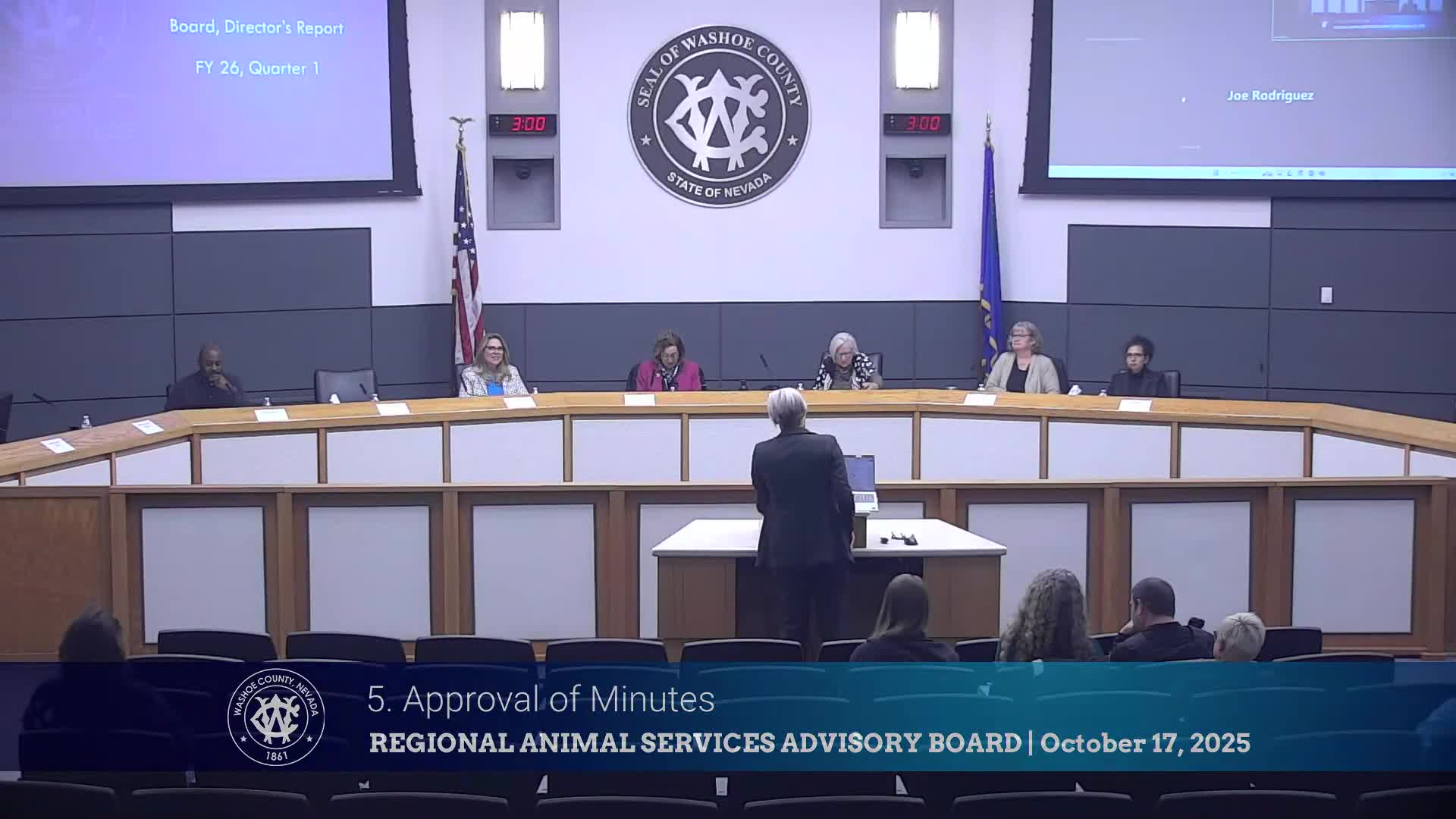Washoe County animal services reports lower intake, higher microchip rates; euthanasia and reunification figures detailed
October 18, 2025 | Washoe County, Nevada
This article was created by AI summarizing key points discussed. AI makes mistakes, so for full details and context, please refer to the video of the full meeting. Please report any errors so we can fix them. Report an error »

Washoe County Regional Animal Services Director Cheyenne Shull presented the agency's quarter‑1 fiscal‑year‑26 intake and outcome statistics, telling the advisory board the shelter saw its lowest total number of animals for the same quarter across the last four fiscal years.
Shull said the agency remains primarily a government “lost and found” shelter and clarified, “we do not have an adoption program.” She described the county's transfer partnership with the Nevada Humane Society and the resulting operational changes that followed a 2024 agreement on transfer percentages.
The data Shull presented show species shifts: cat intake rose about 9 percent, dog intake fell about 4 percent, and “other” animals (pocket pets, reptiles, livestock) decreased about 19 percent compared with the same quarter in prior years. Microchipping was higher than previously reported: roughly 13 percent of incoming cats and 51 percent of dogs were already microchipped.
Shull reviewed outcomes. Field staff reunited 280 animals in the field — about 39 percent of animals picked up by field teams — avoiding shelter intake; 435 animals were impounded and brought to the shelter. Euthanasia totals for the quarter were 56 dogs and 41 cats. For dogs, Shull itemized reasons: 37 determined behaviorally unsafe, one declared dangerous via hearing and surrendered for euthanasia by its owner, 12 not transferred because of lack of rescue capacity or interest, one at owner request, and five for poor quality of life. Cat euthanasias included one owner request and 40 for poor quality of life.
Shull also summarized public‑safety and field operations: about 5,250 field service calls were handled in the quarter across bite/quarantine, noise complaints, trapping and stray animal calls, and welfare calls. She said the field division had periods below minimum staffing because four officers were on modified duty but that teams covered 8 a.m. to 10 p.m., 365 days a year.
Why it matters: the figures frame the operational pressures on a county shelter that does not run an adoption program and depends on rescue partners for live outcomes. The board asked for continued reporting and context on transfers, microchip reunifications and the behavior program used to screen animals for transfer.
Shull closed by noting the shelter is working to expand behavior assessments and tracking of transfer partners so the agency can plan for animals that are not transferred to other rescues.
Shull said the agency remains primarily a government “lost and found” shelter and clarified, “we do not have an adoption program.” She described the county's transfer partnership with the Nevada Humane Society and the resulting operational changes that followed a 2024 agreement on transfer percentages.
The data Shull presented show species shifts: cat intake rose about 9 percent, dog intake fell about 4 percent, and “other” animals (pocket pets, reptiles, livestock) decreased about 19 percent compared with the same quarter in prior years. Microchipping was higher than previously reported: roughly 13 percent of incoming cats and 51 percent of dogs were already microchipped.
Shull reviewed outcomes. Field staff reunited 280 animals in the field — about 39 percent of animals picked up by field teams — avoiding shelter intake; 435 animals were impounded and brought to the shelter. Euthanasia totals for the quarter were 56 dogs and 41 cats. For dogs, Shull itemized reasons: 37 determined behaviorally unsafe, one declared dangerous via hearing and surrendered for euthanasia by its owner, 12 not transferred because of lack of rescue capacity or interest, one at owner request, and five for poor quality of life. Cat euthanasias included one owner request and 40 for poor quality of life.
Shull also summarized public‑safety and field operations: about 5,250 field service calls were handled in the quarter across bite/quarantine, noise complaints, trapping and stray animal calls, and welfare calls. She said the field division had periods below minimum staffing because four officers were on modified duty but that teams covered 8 a.m. to 10 p.m., 365 days a year.
Why it matters: the figures frame the operational pressures on a county shelter that does not run an adoption program and depends on rescue partners for live outcomes. The board asked for continued reporting and context on transfers, microchip reunifications and the behavior program used to screen animals for transfer.
Shull closed by noting the shelter is working to expand behavior assessments and tracking of transfer partners so the agency can plan for animals that are not transferred to other rescues.
View full meeting
This article is based on a recent meeting—watch the full video and explore the complete transcript for deeper insights into the discussion.
View full meeting